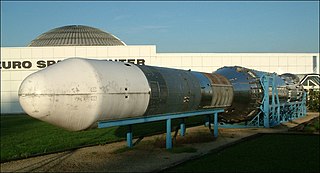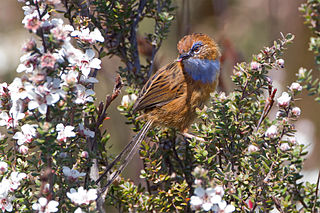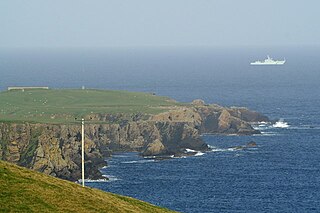
The European Launcher Development Organisation (ELDO) is a former European space research organisation. It was first developed in order to establish a satellite launch vehicle for Europe. The three-stage rocket developed was named Europa, after the mythical Greek goddess. Overall, there were 10 launches that occurred under ELDO's funding. The organisation consisted of Belgium, Britain, France, Germany, Italy, and the Netherlands. Australia was an associate member of the organisation.
The Garma Festival of Traditional Cultures (Garma) is Australia's largest Indigenous cultural gathering, taking place over four days each August in northeast Arnhem Land, in the Northern Territory, Australia. Hosted by the Yothu Yindi Foundation, Garma is a celebration of the cultural traditions of the Yolngu people, and a major community gathering for the clans and families of the Arnhem Land region. The event showcases traditional miny'tji (art), ancient story-telling, manikay (song), and bunggul (dance). It is held at Gulkula, a significant Gumatj ceremonial site about 40 kilometres (25 mi) from the township of Nhulunbuy, attracts more than 2500 guests each year and is often sold out months in advance.

This is a timeline of first orbital launches by country. While a number of countries, incl. Canada, Australia, Germany, Brazil, Algeria, Kazakhstan, Turkey, Argentina, Italy, Malaysia, Poland, South Africa, the Philippines, Egypt, Spain, Mexico, Thailand and Chile, have built or launched satellites, as of 2022, eleven countries, incl. the United States, Japan, China, India, Iran, Israel, France, the United Kingdom and South Korea, have had the capability to send objects into orbit with their own launch vehicles. Russia and Ukraine inherited the capability of the space launchers and satellites from the Soviet Union, following its dissolution in 1991. Russia launches its rockets from its own and foreign (Kazakh) spaceports.

Yalata is an Aboriginal community located 200 kilometres (120 mi) west of Ceduna and 140 km (87 mi) south of Ooldea on the edge of the Nullarbor Plain in South Australia. It lies on the traditional lands of the Wirangu people, but the settlement began as Yalata Mission in the early 1950s when Pila Nguru people were moved from Ooldea Mission when that closed, after previously being moved from their land in the Great Victoria Desert owing to nuclear testing by the British Government.

The Mid-Atlantic Regional Spaceport (MARS) is a commercial space launch facility located at the southern tip of NASA's Wallops Flight Facility on Wallops Island in Virginia, just east of the Delmarva Peninsula and south of Chincoteague, Virginia, United States. It is owned and operated by the Virginia Spaceport Authority.

The southern emu-wren is a species of bird in the Australasian wren family, Maluridae. It is endemic to Australia. Its natural habitats are temperate forests, and Mediterranean-type shrubby vegetation, and swamplands.

Abbot Point Port is home to the North Queensland Export Terminal (NQXT), the most northerly deepwater coal port of Australia, situated approximately 25 kilometres (16 mi) north-west of the township of Bowen (Queensland). Established in 1984, it consists of a rail in-loading facility, coal handling and stockpile areas, and a single trestle jetty and conveyor connected to a berth and shiploader, located 2.75 km off-shore. Coal reaches the port via the GAP railway line from the Bowen Basin Coalfields.

Rocket Lab USA, Inc. is a publicly traded aerospace manufacturer and launch service provider that operates and launches lightweight Electron orbital rockets used to provide dedicated launch services for small satellites as well as a suborbital variant of Electron called HASTE. The company plans to build a larger Neutron rocket as early as 2024. Electron rockets have launched to orbit 46 times from either Rocket Lab's Launch Complex 1 in New Zealand or at the Mid-Atlantic Regional Spaceport in Wallops Island, Virginia, United States. Rocket Lab has launched one sub-orbital HASTE rocket to date from Wallops Island, Virginia. In addition to the Electron, Neutron, and HASTE launch vehicles, Rocket Lab manufactures and operates spacecraft and is a supplier of satellite components including star trackers, reaction wheels, solar cells and arrays, satellite radios, separation systems, as well as flight and ground software.

Andøya Space, also named Andøya Space Center and formerly Andøya Rocket Range, is a rocket launch site, rocket range, and spaceport on Andøya island in Andøy Municipality in Nordland county, Norway. Since 1962, over 1,200 sounding and sub-orbital rockets of various configurations have been launched from the site.
Koonibba is a locality and an associated Aboriginal community in South Australia located about 586 kilometres (364 mi) northwest of the state capital of Adelaide and about 38 km (24 mi) northwest of the municipal seat in Ceduna and 5 km (3.1 mi) north of the Eyre Highway.

Rocket Lab Launch Complex 1 is a commercial spaceport located close to Ahuriri Point at the southern tip of Māhia Peninsula, on the east coast of New Zealand's North Island. It is owned and operated by private spaceflight company Rocket Lab and supports launches of the company's Electron rocket for small satellites. The facility officially opened on 26 September 2016 (UTC). With the launch of Electron on 25 May 2017, it became the first private spaceport to host an orbital launch attempt, and the first site in New Zealand to host an orbital launch attempt. With the Electron launch of 21 January 2018, it became the first private spaceport to host a successful orbital launch.

Gilmour Space Technologies is a venture-funded Australian aerospace company that is developing hybrid-propellant rocket engines and associated technologies to support the deployment of a low-cost launch vehicle.
Black Sky Aerospace (BSA) is an Australian private aerospace company, headquartered in Logan, Queensland. BSA specialises in payload delivery systems through proprietary propulsion systems, componentry and vehicles. BSA also provides access to calibration and simulation systems.
Whalers Way Orbital Launch Complex is a proposed rocket-launching facility operated by Southern Launch at Whalers Way, in the locality of Sleaford near Port Lincoln on South Australia's Eyre Peninsula.

TiSPACE, officially Taiwan Innovative Space Inc., is a space launch company from Taiwan. Its sister company, ATSpace, is headquartered in South Australia.
Koonibba is a locality and an Aboriginal community in South Australia.

The Koonibba Test Range is a rocket test range site near the township of Koonibba in the far west of South Australia. Rockets are launched to the north over a clear area – the Yumbarra Conservation Park and Yellabinna Wilderness Protection Area – for 145 kilometres (90 mi).

SaxaVord Spaceport, previously known as Shetland Space Centre, is a spaceport located on the Lamba Ness peninsula on Unst, the most northerly of the Shetland Islands off of mainland Scotland. The site is near the RAF Saxa Vord radar station and the settlement of Skaw, adjacent to the Saxa Vord distillery.
The Arnhem Space Centre (ASC) is Australia's first and only commercial spaceport, located near Nhulunbuy, in Arnhem Land, Australia. It is owned and operated by Equatorial Launch Australia (ELA), and it is the site of NASA's first non-orbital sounding rocket launch from a commercial port outside the United States on 27 June 2022.
HyImpulse is a German private space launch enterprise headquartered in Neuenstadt am Kocher and developing a small launch vehicle designed around hybrid-propellant rockets. The company is a DLR spinoff founded in 2018 out of the chemical propulsion center of the German space agency's Lampoldshausen facility. HyImpulse is bankrolled by Rudolf Schwarz, chairman of German technology company IABG.













